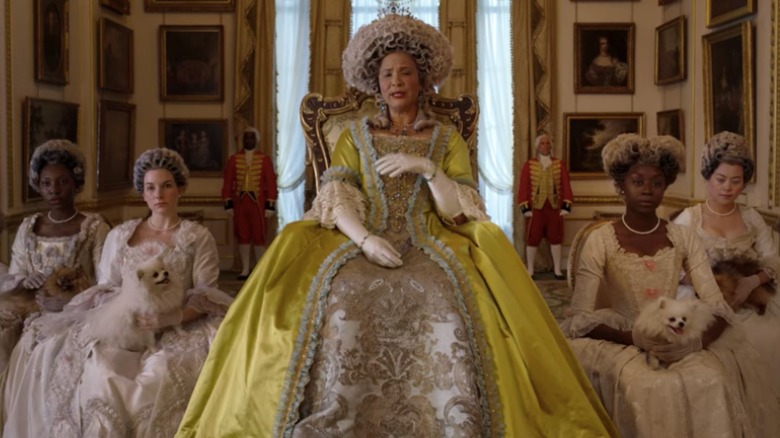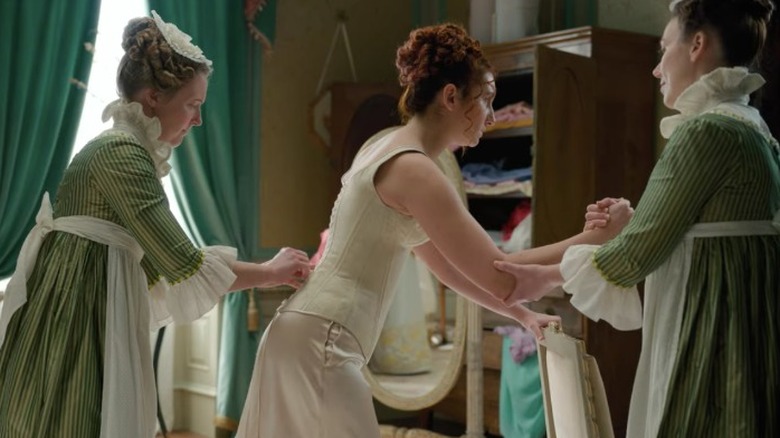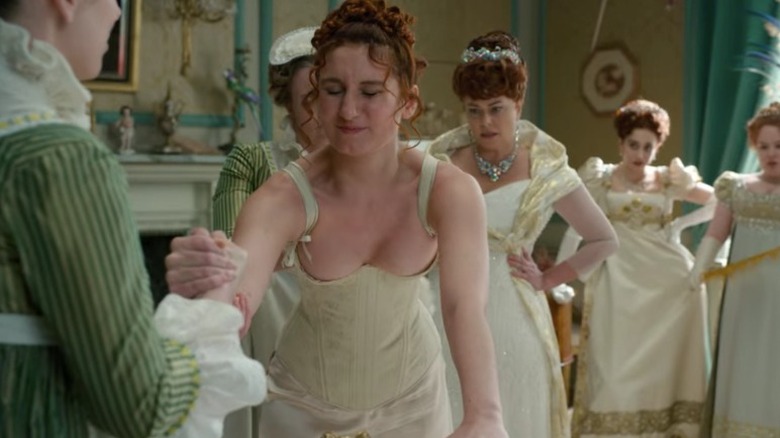Why Bridgerton's Costumes Are So Inaccurate According To Historians
When "Bridgerton" debuted on Netflix on December 25th of 2020, it instantaneously wooed audiences with its steamy spin on early 19th century England, its refusal to play by the often-banal rules of the conventional "Period Piece" formula, and its willingness to employ aesthetic, musical, and historical anachronisms in an effort to tell the story it wanted to tell. Adapted from writer Julia Quinn's best-selling historical fiction series, the Emmy Award-winning phenomenon is at once painstakingly accurate with regard to certain elements of its Regency Era setting — e.g., Queen Charlotte was likely a woman of color (via The Charlotte Observer) — and willing to enhance or alter the truth a little to make its narrative more compelling — e.g., Queen Charlotte did not rule in response to her husband's mental illness: her son did, via The 1811 Regency Act, hence the name of the era (via Intriguing History).
Some of the show's intentional re-imaginings are more subtle. Its use of smoking, for instance, at a time when snuff would have been far more popular with the nobility in particular, is easy to overlook when it does as much as it does to establish a given character's rebelliousness (in this case, that of Claudia Jessie's Eloise Bridgerton). On the other hand, costume designer Ellen Mirojnick's enthusiastic use of decadent fabrics and dizzying color palettes that — much like the couture confections of Sofia Coppola's "Marie Antoinette" — contain so much hypnotic and palpable razzle-dazzle that they become a character in and of themselves.
That character, however — at least according to historians — may well be one of the series' most overt dismissals of reality.
Bridgerton gets corsets all wrong, say historians
According to historian Alden O'Brien — costume and textile curator at Washington D.C.'s Daughters of the American Revolution Museum — there's one oft-use element of attire that "Bridgerton," like so many period pieces, employs not for its historical accuracy, but for its ability to act as an obvious metaphor: that is, the dreaded corset.
Speaking to Smithsonian Magazine, O'Brien explained that while it's tempting to use the undergarment as a tangible representation of "women's restricted roles in society," in this case (and a litany of others) it doesn't actually work. For those unfamiliar with the genre's obsessive use of corsetry as a stand-in for the oppressive nature of a patriarchal society, Smithsonian's Rachel Kaufman provides a number of examples: "Think of 'Gone With the Wind's' Scarlett O'Hara death-gripping a bedpost," she writes, or "Elizabeth Swann in 'Pirates of the Caribbean' [...] Titanic's Rose in a nearly identical scene [...]" and, of course, "Emma Watson, playing Belle in Disney's live-action remake of 'Beauty and the Beast,' declaring that her character is too independent to wear a corset." As it turns out, despite Watson's inspiring intentions, the corset is hardly the villain that filmmakers have long supposed. Throughout history, supportive undergarments have come in a wide range of shapes, materials, and sizes, and the corset itself has seen countless evolutions.
In the Regency Era of "Bridgerton" in particular, the article clarifies, corsets "were made of soft cotton ('imagine blue jeans, and turn them white') with stiffer cotton cording for support, and occasionally channels in the back for boning." What's more, as Davidson explains, these undergarments were "normal pieces of clothing" that varied depending on the occasion, and were worn by working women and nobility alike depending on their needs.
Metaphorically and from a fashion standpoint, Bridgerton's corsets are an anachronism
Assuming all corsetry is akin to the short-lived, waist-training, rib cage-breaking torture devices that were an extreme even in the Victorian Era is similar to thinking all bras look and feel like Madonna's famous Jean Paul Gaultier cone bra. But in addition to being inaccurate, Davidson points out, it's insulting: the notion that women "walked around in these uncomfortable things that they couldn't take off, because patriarchy," she tells The Smithsonian, is absurd — "And they put up with it for 400 years? Women are not that stupid."
Our inaccurate understanding of the garment itself notwithstanding, Davidson has another gripe with the corsetry of "Bridgerton" and its use as an extended metaphor. "The way they've cut the garments actually flattens everyone's busts," she explains, which isn't just inaccurate, but counter to the fashion of the era. Corsets of the Regency Era weren't designed to make waists appear thinner. Since the empire waist — which doesn't go in at the waist at all — was in vogue at the time, there'd be no need for that. Instead, they were used to lift and separate the bosom so that the breasts appeared to be "two round globes," not unlike a modern demi-cup or balconette bra, and about as "oppressive," Davidson says, meaning not at all: "who forces people into a bra in the morning?" she asks rhetorically. While there's plenty that the Netflix series gets right about the role and treatment of women in society at the time, it seems its all-too-common calling upon the trope of the torturous corset is, as usual, inaccurate.


